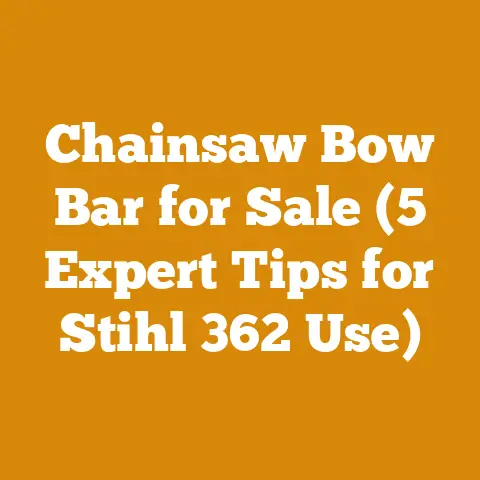Grinding a Stump Safely (5 Pro Tips for Clean Wood Prep)
Let’s face it, dealing with tree stumps is a pain. They’re unsightly, they get in the way, and they can be a breeding ground for pests. But before you reach for the dynamite (please don’t!), let’s talk about a safer, cleaner, and frankly, more satisfying way to get rid of them: stump grinding. I’ve spent years wrestling with wood, from felling giants in the Pacific Northwest to prepping kindling in my own backyard, and I’ve learned a thing or two about making the process efficient and safe. This guide is packed with my experiences and pro tips to help you conquer those stubborn stumps and get your wood prepped right.
The global wood processing and firewood industry is a significant economic driver, with the global firewood market alone estimated to reach billions of dollars in the coming years. Demand is driven by both residential heating needs and the increasing popularity of wood-burning stoves and outdoor fireplaces. According to recent data, firewood consumption has seen a resurgence in many regions due to rising energy costs and a renewed interest in sustainable heating solutions. At the same time, the logging industry is facing increasing pressure to adopt sustainable forestry practices, which includes efficient stump removal and wood waste utilization. This makes understanding proper stump grinding techniques even more critical.
Grinding a Stump Safely: 5 Pro Tips for Clean Wood Prep
The Goal: To safely and effectively grind a tree stump below ground level, allowing for replanting, landscaping, or other uses of the area.
Why Safety Matters: Stump grinding involves a high-speed, rotating cutting wheel that can launch debris at incredible speeds. Personal Protective Equipment (PPE) is non-negotiable.
Understanding the Stump Grinding Landscape
Before we dive into the nitty-gritty, let’s get a handle on the task at hand. Stump grinding isn’t just about making the stump disappear; it’s about doing it safely, efficiently, and with the right tools. Think of it as a mini-excavation project.
What is a Stump Grinder?
A stump grinder is a powerful machine designed to chip away at a tree stump until it’s ground down to below ground level. They come in various sizes, from small, walk-behind models suitable for homeowners to large, tow-behind units for professional use. The heart of the grinder is the cutting wheel, which is equipped with carbide-tipped teeth that chew through the wood.
Why Grind a Stump?
There are several compelling reasons to grind a stump:
- Aesthetics: Let’s be honest, stumps are ugly. Removing them improves the overall appearance of your property.
- Safety: Stumps can be tripping hazards, especially for children and the elderly.
- Land Use: Grinding allows you to reclaim the area for planting, building, or other landscaping projects.
- Pest Control: Stumps can attract insects like termites and carpenter ants, which can then infest your home.
- Disease Prevention: Decaying stumps can harbor fungal diseases that can spread to nearby trees.
Stump Grinding vs. Other Removal Methods
While grinding is often the preferred method, other options exist:
- Digging: Labor-intensive and often impractical for large stumps.
- Burning: Can be dangerous and is often restricted by local ordinances.
- Chemical Removal: Slow and potentially harmful to the environment.
- Explosives: Need I say more? Leave this to the professionals.
In most cases, stump grinding strikes the best balance between effectiveness, safety, and environmental impact.
Pro Tip #1: Gear Up for Success: Personal Protective Equipment (PPE) is King
This isn’t just a suggestion; it’s a requirement. Imagine a high-speed wood chipper throwing rocks, wood chips, and dirt at you. That’s essentially what’s happening during stump grinding. Here’s what you need:
- Eye Protection: Industrial-grade safety glasses or a full-face shield. I’ve seen too many near misses to ever skimp on this. Flying debris can cause serious eye injuries.
- Hearing Protection: Earplugs or earmuffs. Stump grinders are LOUD. Prolonged exposure to that noise level can cause permanent hearing damage.
- Hand Protection: Heavy-duty work gloves. These will protect your hands from splinters, abrasions, and vibrations.
- Leg Protection: Long pants and chainsaw chaps. Yes, even if you’re not using a chainsaw. The chaps will provide an extra layer of protection against flying debris.
- Foot Protection: Steel-toed boots. Protect your feet from falling objects and accidental contact with the grinding wheel.
- Dust Mask or Respirator: Stump grinding creates a lot of dust, which can irritate your lungs. A dust mask will provide basic protection, but a respirator is recommended for prolonged use.
My Experience: I once saw a guy grinding a stump without eye protection. A small piece of wood shot out and hit him square in the eye. Thankfully, he wasn’t seriously injured, but it was a close call. Don’t be that guy.
Pro Tip #2: Know Your Enemy: Stump Assessment and Preparation
Before you fire up the grinder, take some time to assess the stump and prepare the area. This will make the job safer and more efficient.
Stump Size and Type
- Diameter: Measure the diameter of the stump at ground level. This will help you determine the size of the grinder you need.
- Height: How far does the stump protrude above ground? The higher the stump, the more material you’ll need to grind.
- Wood Type: Hardwoods (oak, maple, hickory) are more difficult to grind than softwoods (pine, fir, cedar).
- Root System: How extensive is the root system? You may need to grind beyond the visible stump to remove the major roots.
Site Preparation
- Clear the Area: Remove any rocks, debris, or other obstacles from around the stump. These can damage the grinding wheel or become projectiles.
- Mark Underground Utilities: Call your local utility companies to mark any underground lines before you start grinding. Hitting a gas line or electrical cable could be catastrophic.
- Water the Area: Dampening the area around the stump will help reduce dust.
- Inform Neighbors: Let your neighbors know you’ll be grinding a stump. The noise can be disruptive, and it’s courteous to give them a heads-up.
Equipment Inspection
- Check the Cutting Wheel: Make sure the teeth are sharp and in good condition. Replace any damaged or worn teeth.
- Inspect the Machine: Check the oil level, fuel level, and all other fluids. Make sure all belts and hoses are in good condition.
- Test the Controls: Familiarize yourself with the grinder’s controls before you start grinding. Make sure you know how to stop the machine quickly in an emergency.
Data Point: According to a study by the Tree Care Industry Association (TCIA), improper site preparation is a leading cause of stump grinding accidents. Taking the time to prepare the area can significantly reduce your risk of injury.
Pro Tip #3: Choosing Your Weapon: Stump Grinder Selection
Not all stump grinders are created equal. The right grinder for the job depends on the size and type of stump you’re dealing with.
Types of Stump Grinders
- Walk-Behind Stump Grinders: These are the most common type of grinder for homeowners. They’re relatively easy to operate and maneuver, but they’re not as powerful as larger models.
- Tow-Behind Stump Grinders: These are larger, more powerful grinders that are typically towed behind a truck or tractor. They’re suitable for larger stumps and commercial use.
- Skid-Steer Stump Grinders: These are attachments for skid-steer loaders. They’re very powerful and versatile, but they require specialized equipment.
- Handheld Stump Grinders: These are small, lightweight grinders that are designed for small stumps and tight spaces. They’re not as powerful as other types of grinders, but they’re very portable.
Considerations When Choosing a Grinder
- Stump Size: The larger the stump, the more powerful the grinder you’ll need.
- Wood Type: Hardwoods require more powerful grinders than softwoods.
- Terrain: If you’re working on uneven terrain, you’ll need a grinder that’s easy to maneuver.
- Budget: Stump grinders can range in price from a few hundred dollars to several thousand dollars.
- Rental vs. Purchase: If you only need to grind a few stumps, renting a grinder may be more cost-effective than purchasing one.
Unique Insight: Consider the long-term cost of ownership. While renting might seem cheaper upfront, frequent stump grinding projects might justify the investment in a quality machine. Plus, having your own grinder means you can tackle those pesky stumps whenever they pop up.
Chainsaw vs. Axe for Initial Stump Reduction
Before you even fire up the stump grinder, consider using a chainsaw or axe to reduce the stump’s height. This can significantly speed up the grinding process.
- Chainsaw: Excellent for quickly cutting down the stump to ground level. Use caution to avoid hitting the ground with the chain, as this can dull the teeth.
- Axe: A more traditional approach, but still effective for reducing the stump’s height. Use a splitting axe or maul for larger stumps.
My Story: I once tried to grind a massive oak stump without reducing its height first. It took me hours, and I went through several sets of grinding teeth. Lesson learned: always reduce the stump’s height before grinding.
Pro Tip #4: The Grinding Groove: Mastering the Technique
Now for the fun part! Here’s how to grind a stump safely and effectively:
- Position the Grinder: Position the grinder so that the cutting wheel is directly over the stump.
- Engage the Cutting Wheel: Start the engine and engage the cutting wheel.
- Lower the Wheel: Slowly lower the cutting wheel onto the stump.
- Sweep Back and Forth: Move the grinder back and forth across the stump, chipping away at the wood.
- Grind in Layers: Grind the stump down in layers, working your way down to the desired depth (usually 4-6 inches below ground level).
- Grind the Roots: Once you’ve ground the stump down to the desired depth, grind the major roots that extend out from the stump.
- Backfill the Hole: Fill the hole with soil and compact it.
Key Techniques for Efficient Grinding
- Patience is a Virtue: Don’t try to grind too much material at once. Take your time and work in small increments.
- Sharp Teeth are Essential: Dull teeth will make the job much harder and can damage the grinder. Replace or sharpen the teeth regularly.
- Use the Right Angle: Angle the cutting wheel slightly downward to maximize its cutting efficiency.
- Avoid Obstacles: Be careful to avoid rocks, roots, and other obstacles that can damage the grinding wheel.
- Listen to the Machine: Pay attention to the sound of the grinder. If it starts to sound strained or labored, back off and let it cool down.
Troubleshooting Common Problems
- Grinder Won’t Start: Check the fuel level, oil level, and spark plug. Make sure the engine is properly choked.
- Grinder Stalls: You may be trying to grind too much material at once. Back off and let the grinder cool down.
- Grinding Wheel Gets Stuck: You may have hit a rock or other obstacle. Stop the grinder and remove the obstacle.
- Excessive Vibration: The grinding wheel may be unbalanced. Check the teeth for damage and replace any worn or broken teeth.
Case Study: A local landscaping company was hired to remove several large oak stumps from a residential property. They used a tow-behind stump grinder and followed the techniques outlined above. They were able to grind all the stumps down to the desired depth in just a few hours, leaving the property owner with a clean and level surface for replanting.
Pro Tip #5: Clean Up and Aftercare: Reclaiming Your Space
Once you’ve ground the stump down to the desired depth, it’s time to clean up the area and prepare it for replanting or other uses.
Removing Debris
- Rake the Area: Rake up all the wood chips and debris from around the stump.
- Dispose of Debris: Dispose of the debris properly. You can compost it, use it as mulch, or haul it away to a landfill.
- Consider Using the Mulch: The wood chips from stump grinding can be used as mulch around trees and shrubs. This can help retain moisture, suppress weeds, and improve soil health.
Backfilling the Hole
- Fill the Hole with Soil: Fill the hole with topsoil or other suitable soil.
- Compact the Soil: Compact the soil to prevent settling.
- Add Amendments: Add compost or other soil amendments to improve soil fertility.
Replanting and Landscaping
- Choose the Right Plants: Choose plants that are adapted to the soil conditions in your area.
- Water Regularly: Water the plants regularly, especially during the first few weeks after planting.
- Fertilize as Needed: Fertilize the plants as needed to promote healthy growth.
Stump Grinding Costs and Budgeting
The cost of stump grinding can vary depending on several factors, including:
- Stump Size: Larger stumps cost more to grind.
- Wood Type: Hardwoods cost more to grind than softwoods.
- Accessibility: Stumps that are difficult to access cost more to grind.
- Location: Stump grinding costs can vary depending on your location.
- Rental vs. Professional: Renting a grinder is typically cheaper than hiring a professional, but it requires more time and effort.
Budgeting Tips:
- Get Multiple Quotes: If you’re hiring a professional, get quotes from several different companies.
- Factor in Rental Costs: If you’re renting a grinder, factor in the cost of the rental, fuel, and any other supplies you’ll need.
- Consider DIY: If you’re comfortable doing the work yourself, grinding your own stumps can save you money.
Actionable Tip: Many local municipalities offer wood chipping services or have community compost programs where you can dispose of the debris from stump grinding. Check your local regulations for details.
Common Pitfalls and How to Avoid Them
Even with the best preparation, things can sometimes go wrong. Here are some common pitfalls to watch out for:
- Hitting Underground Utilities: Always call your local utility companies to mark any underground lines before you start grinding.
- Damaging the Grinding Wheel: Avoid hitting rocks, roots, and other obstacles that can damage the grinding wheel.
- Overheating the Grinder: Don’t try to grind too much material at once. Let the grinder cool down periodically.
- Injuries: Always wear the proper PPE and follow safe operating procedures to prevent injuries.
- Poor Cleanup: Take the time to clean up the area properly after grinding the stump.
Friendly Advice: Don’t be afraid to ask for help. If you’re not comfortable grinding a stump yourself, hire a professional. It’s better to be safe than sorry.
Next Steps and Additional Resources
You’ve conquered the stump! Now what? Here are some next steps and additional resources to help you with your wood processing and firewood preparation projects:
- Wood Seasoning: If you’re planning to use the wood from the stump for firewood, be sure to season it properly. This will reduce the moisture content and make it burn more efficiently.
- Woodworking Projects: Consider using the wood from the stump for woodworking projects. You can make furniture, bowls, or other decorative items.
- Tree Planting: Replant a tree in the area where the stump was removed. This will help restore the ecosystem and provide shade and beauty to your property.
- Local Suppliers:
- Tool Rental Companies: Check your local equipment rental companies for stump grinder rentals.
- Logging Tool Suppliers: Forestry suppliers can provide you with logging tools.
- Firewood Drying Equipment Rental Services: Some companies specialize in renting firewood drying equipment for large-scale operations.
- Online Resources:
- Tree Care Industry Association (TCIA): Provides information and resources on tree care and safety.
- International Society of Arboriculture (ISA): Offers certification programs and educational resources for arborists.
- Forest Products Laboratory (FPL): Conducts research on wood and wood products.
Final Thoughts
Grinding a stump safely and effectively is a rewarding experience. It allows you to reclaim your land, improve the appearance of your property, and even create valuable resources for other projects. By following the pro tips and techniques outlined in this guide, you can conquer those stubborn stumps and get your wood prepped right. Remember, safety is always the top priority. Gear up, assess the situation, choose the right tools, master the technique, and clean up after yourself. With a little patience and effort, you’ll be well on your way to a stump-free landscape. Happy grinding!






